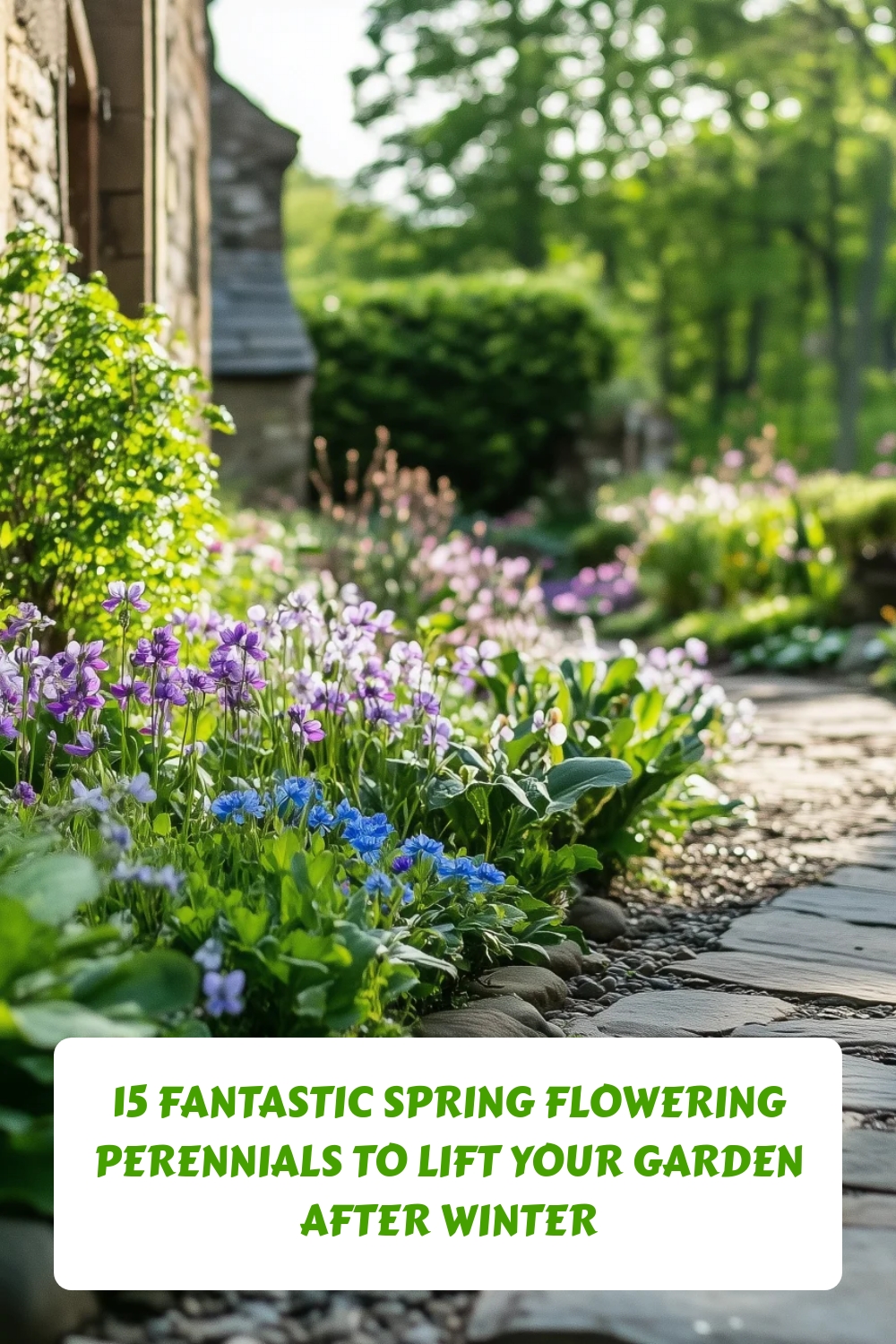
One of the greatest moments in the year for me is the emergence of new growth in late winter and early spring. It really lifts my heart when I see the first snowdrops and crocuses and the first spears of daffodil foliage thrusting through the soil.
After winter’s gloom, the vibrant colours and fresh scents of spring flowering bulbs like daffodils, tulips, and crocuses revitalise outdoor spaces. Yet, these classic bulbs are only part of the story: introducing spring flowering perennials can really add something extra to the tapestry of the Spring garden.
Perennials such as hellebores, primroses, and creeping phlox start to bloom around the same time, extending the season and bridging gaps between early bulbs and later showstoppers. By pairing bulbs with perennials, gardeners create pattern of colour, texture, and height, ensuring there is always something new to admire.
As bulbs fade, perennials pick up the baton, adding fresh vibrancy to beds and borders. Together, the species we feature here offer a seamless progression from early spring into early summer.
These 15 spring flowering perennials can help help create a lively, uplifting display that celebrates the full potential of the season. They work alongside bulbs to ensure colour, fragrance, and delight for weeks on end, helping your flower garden emerge positively winter’s darkness and chill.
Hellebore (Lenten Rose)
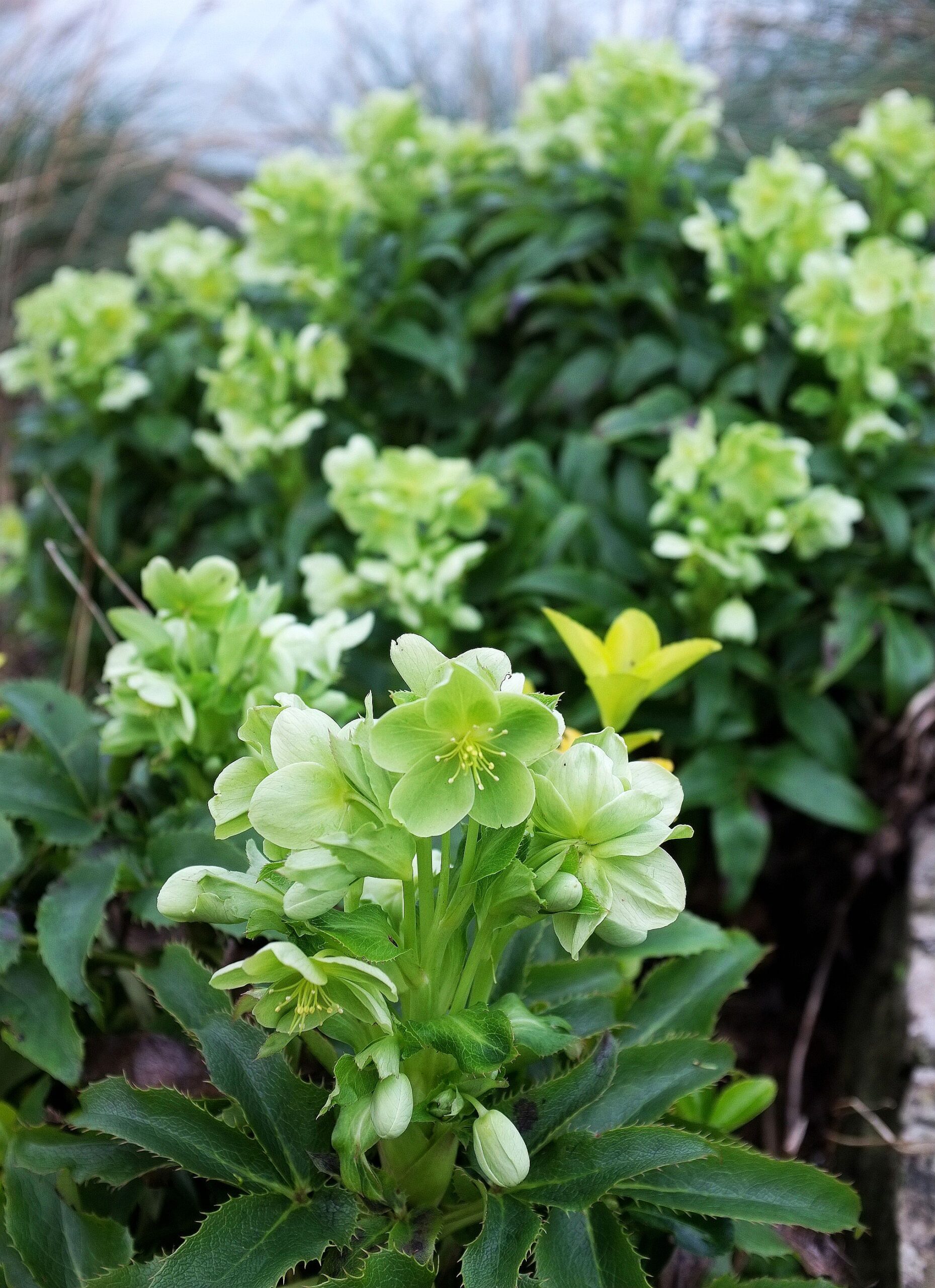
Hellebores are unusual because they can flower even in late winter, sometimes pushing through snow. Their nodding blooms protect inner structures from cold and damp. The plant’s leathery, often evergreen leaves add year-round interest.
Key facts
- Scientific name and any synonyms: Helleborus × hybridus (commonly referred to as hybrid hellebore; formerly known as Helleborus orientalis hybrids)
- Meaning of scientific plant name: “Helleborus” comes from the Greek words helein (“to injure”) and bora (“food”), hinting at its toxic properties
- Common names: Lenten rose, oriental hellebore
- Plant family: Ranunculaceae
- Place of origin of the plant: Native to parts of Europe and western Asia
- Type of plant: Herbaceous or semi-evergreen perennial
- Size: Typically 30–45 cm tall (12–18 inches), spreading 30–60 cm (12–24 inches)
- Foliage – Description of foliage: Dark green, leathery, divided leaves; can remain evergreen in mild climates
- Flower – Description of flower and flowering time: Cup-shaped, downward-facing flowers in shades of white, pink, green or purple; late winter to early spring
- Fruit – Description of fruit (if any) and fruiting time: Seed pods develop after flowering; seeds ripen in spring/early summer
- Toxicity: All parts are poisonous to pets and humans. The Royal Horticultural Society (RHS) notes ingestion can cause severe discomfort, and sap may irritate skin.
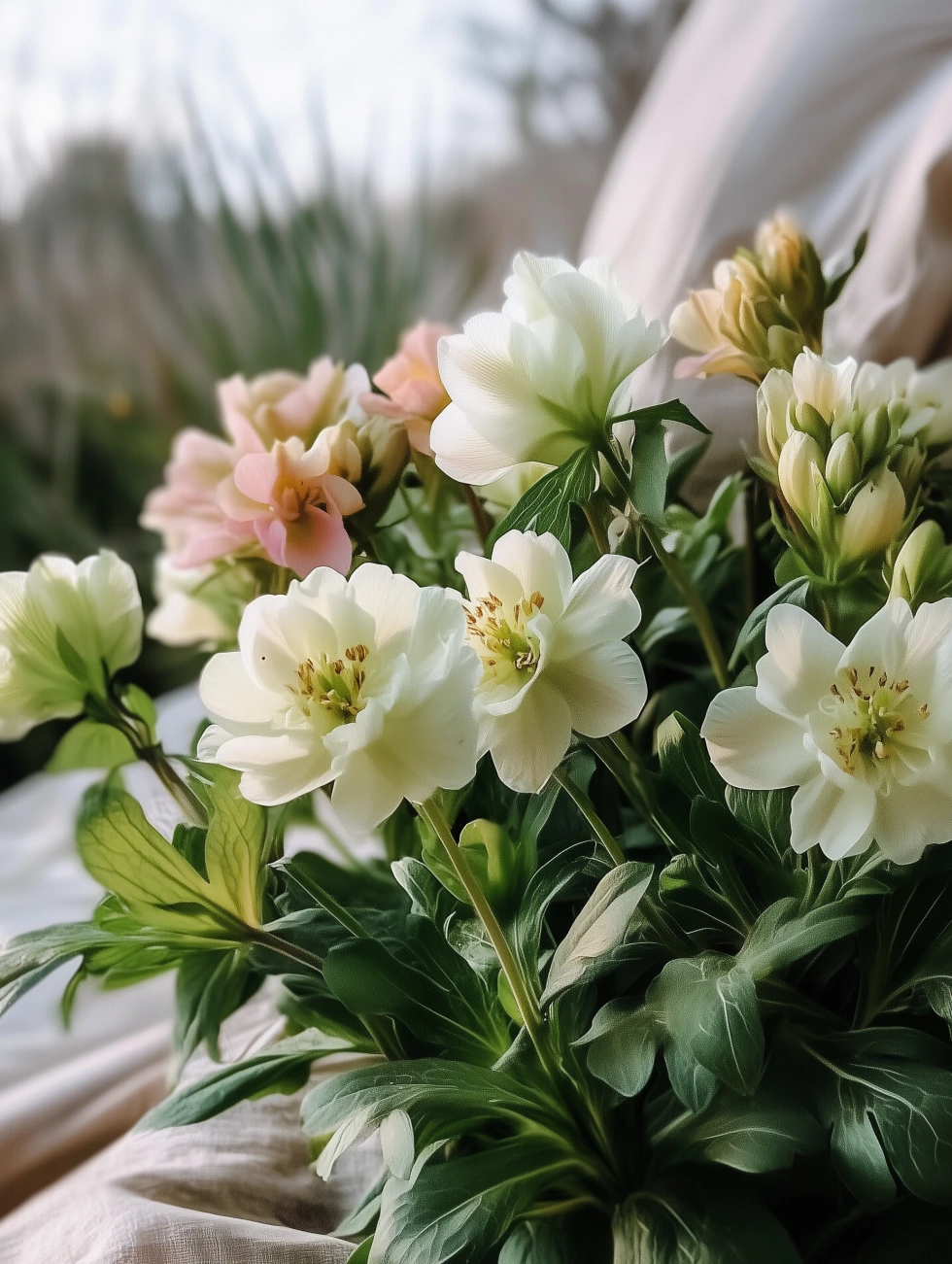
Care requirements
- Light requirements: Partial to full shade, especially in warmer regions.
- Water and humidity requirements: Keep soil consistently moist but not waterlogged; moderate humidity is sufficient.
- Temperature requirements (including minimum and maximum in °F and °C) and UK/US hardiness zones: Generally hardy between about 5 °F (-15 °C) and 75 °F (24 °C). UK hardiness: H5. US hardiness: USDA zones 4–9.
- Soil requirements: Rich, well-draining soil with abundant organic matter.
- Feeding requirements: Apply a balanced, slow-release fertiliser in early spring.
- Propagation – summary of main ways of propagating the plant: Division after flowering or by seed (seedlings may vary from parent).
- Pruning – summary of when and how to prune the plant: Remove old, damaged leaves in late winter before new growth appears, to showcase blooms.
Best cultivars
- ’Red Lady’ – Deep red flowers, around 35 cm tall, dramatic winter colour.
- ’White Spotted Lady’ – White flowers with red speckles, 40 cm tall, eye-catching pattern.
- ’Yellow Lady’ – Pale yellow petals, 30–40 cm tall, cheerful hue.
- ’Blue Metallic Lady’ – Dusky purple blooms, approx. 40 cm tall, semi-metallic sheen.
- ’Peppermint Ice’ – Pink outer petals and lighter centres, about 35 cm tall, double flowers.
Primrose (Primula)
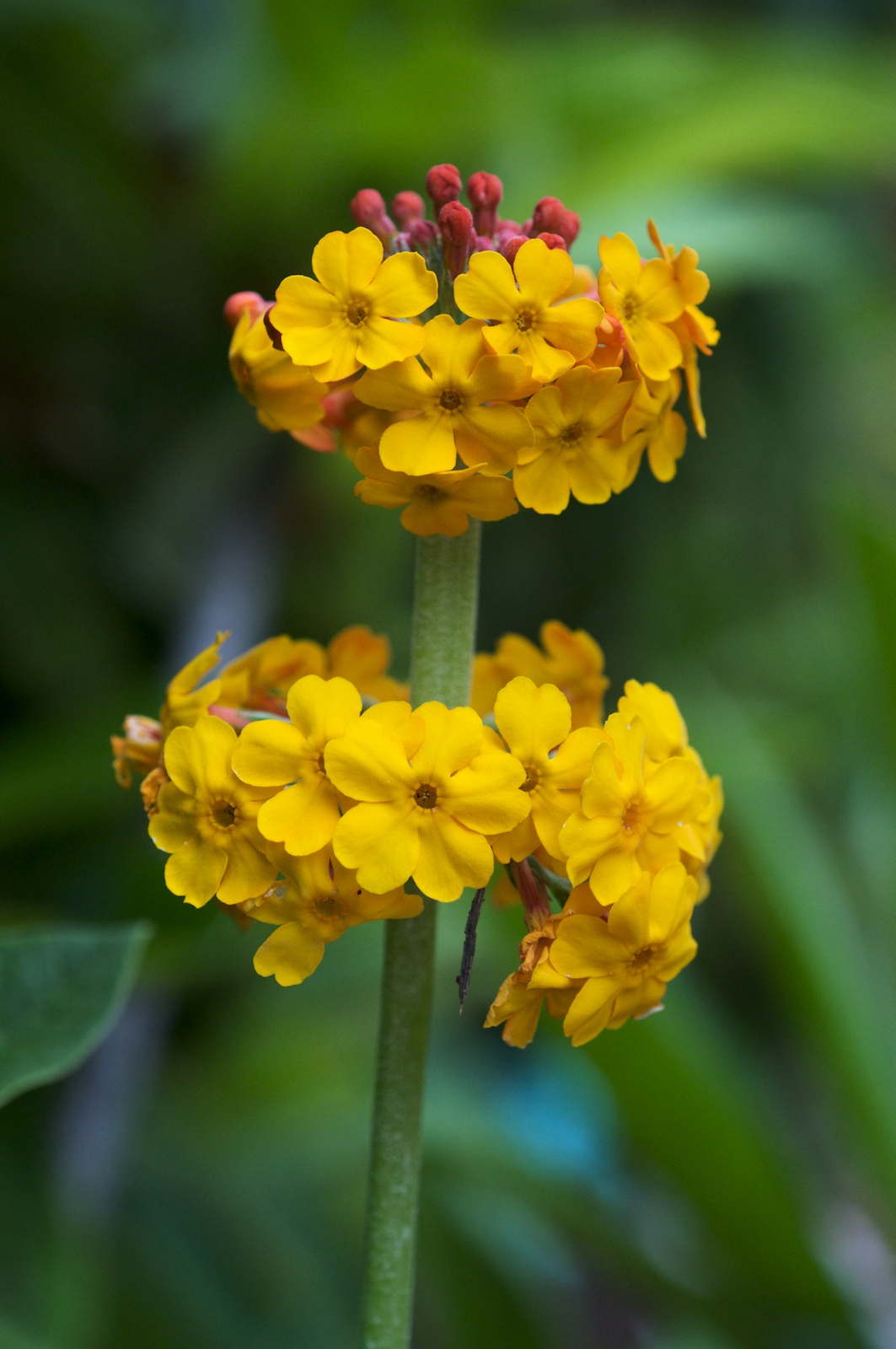
Primroses are among the earliest spring flowers, brightening borders and containers when little else is in bloom. Many varieties have a sweet fragrance.
Key facts
- Scientific name and any synonyms: Primula vulgaris (syn. Primula acaulis)
- Meaning of scientific plant name: “Primula” comes from the Latin primus (“first”), referring to early bloom
- Common names: Primrose, common primrose, English primrose
- Plant family: Primulaceae
- Place of origin of the plant: Europe, northwestern Africa, and parts of southwest Asia
- Type of plant: Herbaceous perennial
- Size: 10–15 cm tall (4–6 inches), spreading 15–20 cm (6–8 inches)
- Foliage – Description of foliage: Low rosettes of wrinkled, oval leaves with toothed edges
- Flower – Description of flower and flowering time: Single or double blooms in yellow, pink, purple, red; early to mid-spring
- Fruit – Description of fruit (if any) and fruiting time: Small seed capsules after flowering, maturing in late spring/summer
- Toxicity: Generally non-toxic, though leaves can irritate skin. The RHS notes minor potential for irritation but no serious hazard.
Care requirements
- Light requirements: Partial shade is ideal; can handle full sun in cooler regions.
- Water and humidity requirements: Keep soil evenly moist; avoid letting plants dry out.
- Temperature requirements (including minimum and maximum in °F and °C) and UK/US hardiness zones: Thrive around 41 °F (5 °C) to 68 °F (20 °C). UK hardiness: H5. US hardiness: USDA zones 4–8.
- Soil requirements: Moist, well-draining, humus-rich soil.
- Feeding requirements: Light feeding with a balanced fertiliser in spring.
- Propagation – summary of main ways of propagating the plant: Divide clumps after flowering or start from seed.
- Pruning – summary of when and how to prune the plant: Remove spent blooms and yellowing leaves to keep plants tidy.
Best cultivars
- ’Blue Zebra’ – Striped blue and white flowers, 15 cm tall, striking pattern.
- ’Belarina Cream’ – Double cream flowers, 12 cm tall, long flowering period.
- ’Hethor Giant’ – Larger blooms in mixed colours, 15–20 cm tall, robust growth.
- ’Wanda’ – Magenta blooms, around 10 cm tall, a heritage variety.
- ’Drumcliff’ – White flowers with a yellow eye, purple-tinted foliage, 15 cm tall.
Bleeding Heart (Lamprocapnos Spectabilis)
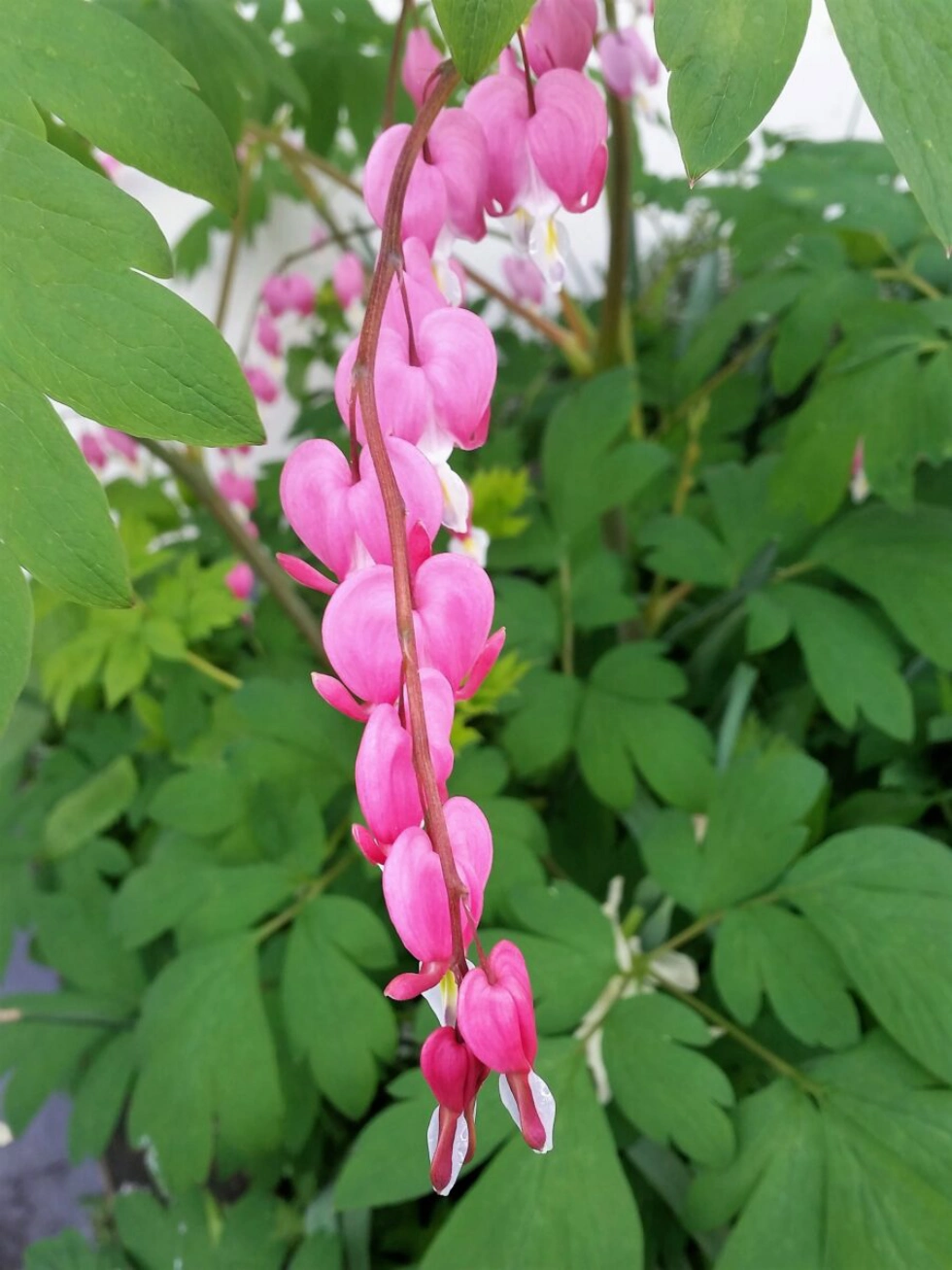
Bleeding heart features graceful, arching stems lined with heart-shaped flowers. Its delicate blooms lend a romantic charm to shaded borders.
Key facts
- Scientific name and any synonyms: Lamprocapnos spectabilis (syn. Dicentra spectabilis)
- Meaning of scientific plant name: “Lamprocapnos” is Greek for “bright smoky plant,” describing the luminous bloom appearance
- Common names: Bleeding heart, lady-in-a-bath
- Plant family: Papaveraceae
- Place of origin of the plant: Eastern Asia (China, Korea, Japan)
- Type of plant: Herbaceous perennial
- Size: 60–90 cm tall (24–36 inches), 30–60 cm spread (12–24 inches)
- Foliage – Description of foliage: Soft, fern-like leaves that often go dormant in summer
- Flower – Description of flower and flowering time: Heart-shaped pink or white blooms, mid to late spring
- Fruit – Description of fruit (if any) and fruiting time: Small pods with black seeds, after blooms fade
- Toxicity: Contains alkaloids; ingestion can be harmful to pets or humans. The RHS notes possible mild skin irritation when handling.
Care requirements
- Light requirements: Partial to full shade (especially in hotter regions).
- Water and humidity requirements: Keep soil evenly moist; average humidity is fine.
- Temperature requirements (including minimum and maximum in °F and °C) and UK/US hardiness zones: Thrives between about 39 °F (4 °C) and 75 °F (24 °C). UK hardiness: H5. US hardiness: USDA zones 3–9.
- Soil requirements: Well-draining, moderately fertile, slightly acidic soil.
- Feeding requirements: Compost or a balanced fertiliser in early spring.
- Propagation – summary of main ways of propagating the plant: Division in early spring or early autumn; seeds can be sown but are slower.
- Pruning – summary of when and how to prune the plant: Cut back foliage after it yellows in summer; remove spent stems.
Best cultivars
- ’Alba’ – Pure white blooms, 60 cm tall, brightens shady corners.
- ’Gold Heart’ – Chartreuse-gold foliage, pink blooms, around 70 cm tall.
- ’Valentine’ – Red-pink blooms with white centres, 75 cm tall, vibrant colour.
- ’Hordival’ – Pink and white flowers, about 80 cm tall, prolific.
- ’Fire Island’ – Deep red blooms, 60 cm tall, compact habit.
Pulmonaria (Lungwort)
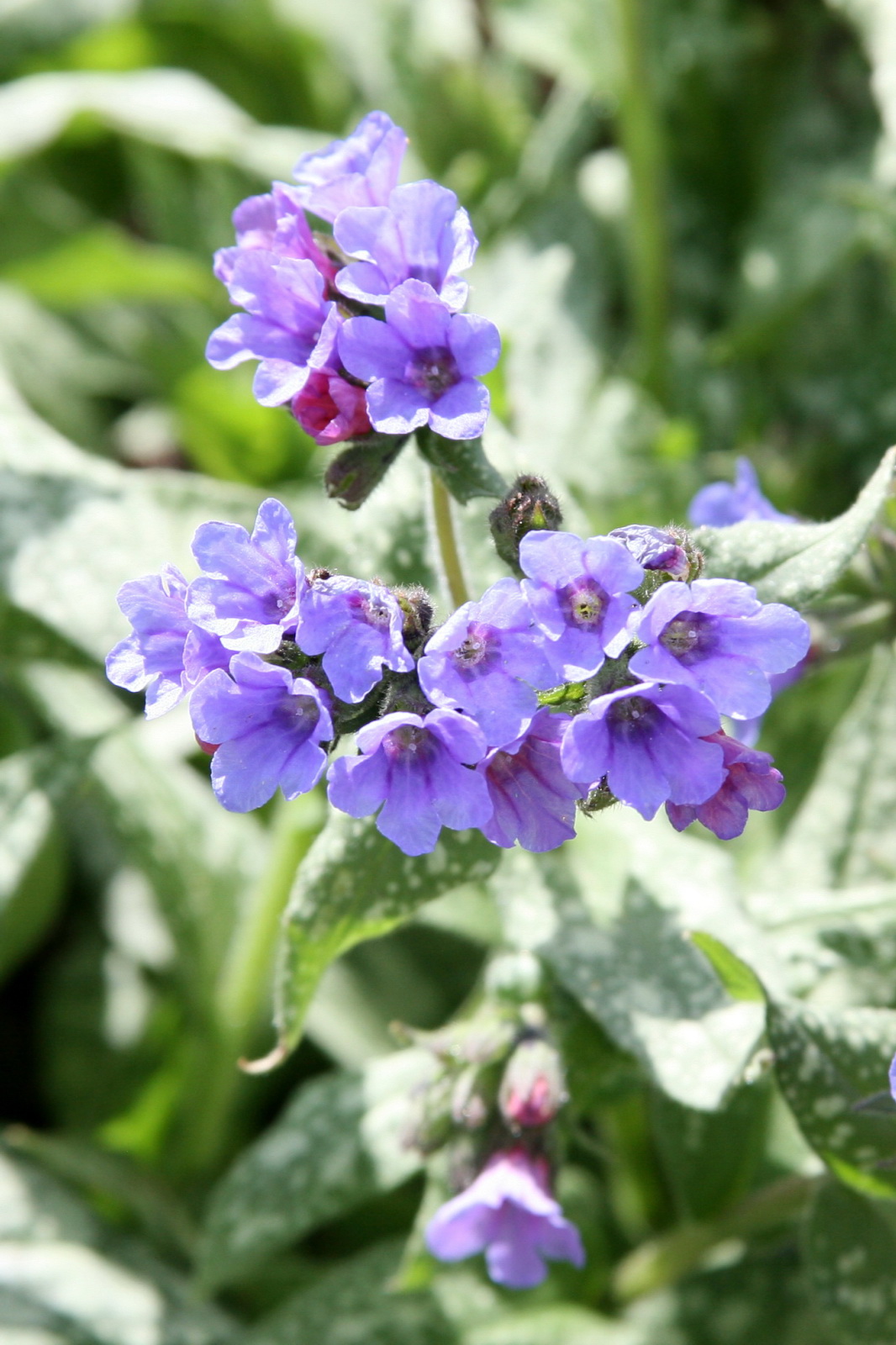
Pulmonaria stands out for its spotted or silvery leaves. Many varieties produce flowers that start pink and then turn blue, creating a two-tone effect on the same plant.
Key facts
- Scientific name and any synonyms: Pulmonaria officinalis; also Pulmonaria saccharata, Pulmonaria rubra
- Meaning of scientific plant name: “Pulmonaria” is from Latin pulmo (“lung”), referencing old medicinal uses
- Common names: Lungwort, Bethlehem sage, soldiers and sailors
- Plant family: Boraginaceae
- Place of origin of the plant: Europe and western Asia
- Type of plant: Herbaceous perennial
- Size: 20–30 cm tall (8–12 inches), spreading 30–45 cm (12–18 inches)
- Foliage – Description of foliage: Oval, often spotted or variegated leaves; semi-evergreen in some climates
- Flower – Description of flower and flowering time: Funnel-shaped flowers in pinks, blues, whites, or purples; early to mid-spring
- Fruit – Description of fruit (if any) and fruiting time: Small nutlets post-flowering, ripening in late spring
- Toxicity: Generally non-toxic, though not recommended for consumption. No major pet or human toxicity reported by the RHS.
Care requirements
- Light requirements: Partial to full shade, particularly in hotter regions.
- Water and humidity requirements: Keep soil evenly moist; moderate garden humidity is sufficient.
- Temperature requirements (including minimum and maximum in °F and °C) and UK/US hardiness zones: Hardy between about -4 °F (-20 °C) and 75 °F (24 °C). UK hardiness: H5. US hardiness: USDA zones 3–8.
- Soil requirements: Moist, humus-rich, well-draining soil.
- Feeding requirements: Top-dress with compost each year; a light fertiliser in spring can help.
- Propagation – summary of main ways of propagating the plant: Division in autumn or after flowering; also grown from seed (hybrids may vary).
- Pruning – summary of when and how to prune the plant: Remove old or damaged leaves after flowering.
Best cultivars
- ’Blue Ensign’ – Solid green leaves, bright blue flowers, 30 cm tall.
- ’Diana Clare’ – Silver-flecked foliage, violet-blue blooms, 25 cm tall.
- ’Raspberry Splash’ – Pink blooms turning purple, spotted leaves, 30 cm tall.
- ’Trevi Fountain’ – Silvery foliage, bluish-purple flowers, 25 cm tall.
- ’Majeste’ – Silver-grey leaves, pink-to-blue flowers, about 20 cm tall.
Creeping Phlox (Phlox Subulata)
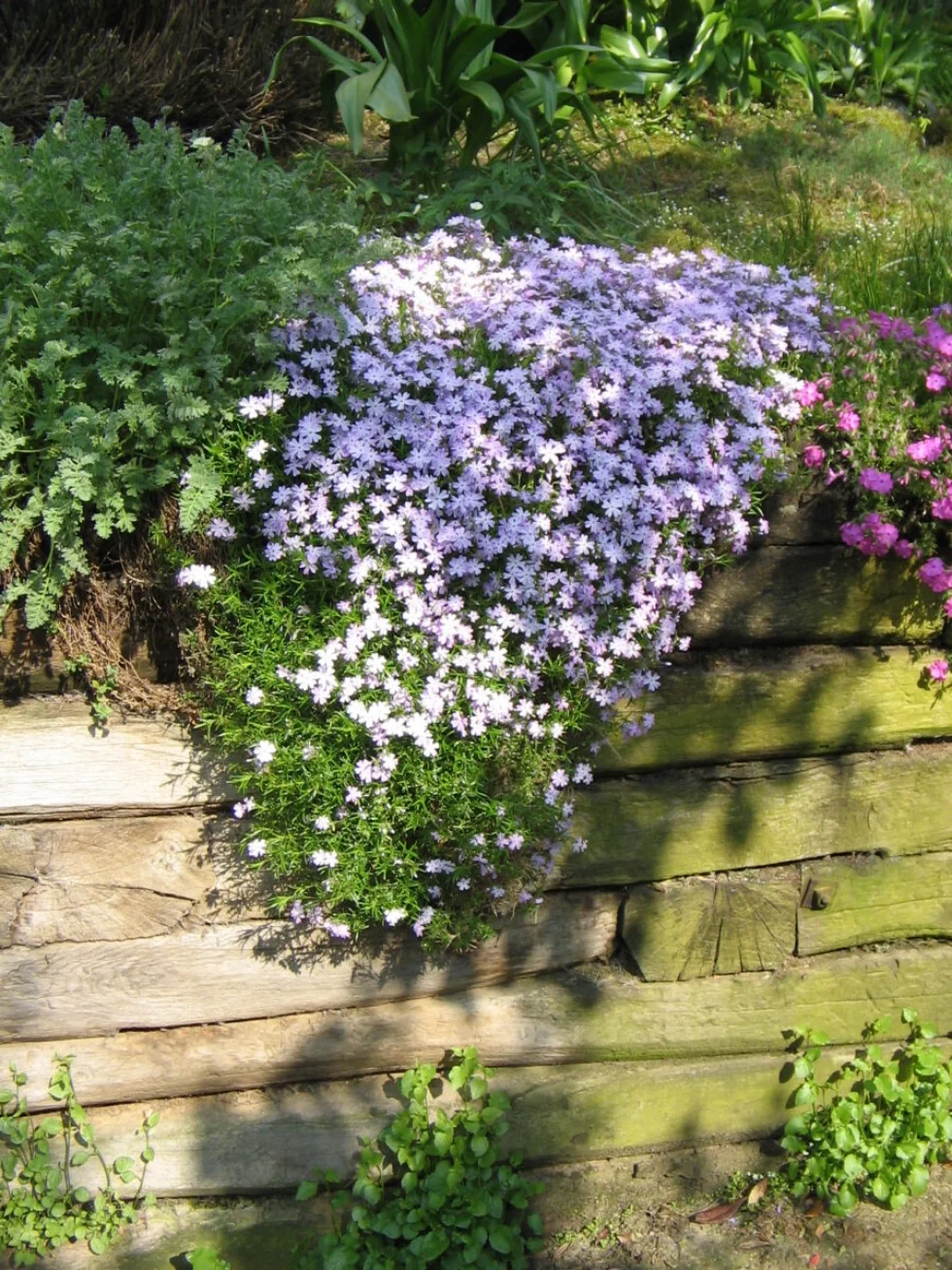
Creeping phlox forms a dense, low-growing mat of bright spring colour. It’s perfect for rock gardens, slopes, or edges where it can cascade gracefully.
Key facts
- Scientific name and any synonyms: Phlox subulata
- Meaning of scientific plant name: “Phlox” is Greek for “flame,” referencing the vibrant flower colours
- Common names: Creeping phlox, moss phlox, mountain phlox
- Plant family: Polemoniaceae
- Place of origin of the plant: Eastern and central United States
- Type of plant: Evergreen, mat-forming perennial
- Size: 10–15 cm tall (4–6 inches), can spread up to 60 cm (24 inches)
- Foliage – Description of foliage: Needle-like, evergreen leaves forming a mossy mat
- Flower – Description of flower and flowering time: Star-shaped, typically pink, purple, blue, or white; blooms mid to late spring
- Fruit – Description of fruit (if any) and fruiting time: Small seed capsules in summer
- Toxicity: Considered non-toxic to pets and humans. No issues noted by ASPCA or RHS.
Care requirements
- Light requirements: Full sun for optimal flowering.
- Water and humidity requirements: Moderate watering; fairly drought-tolerant once established.
- Temperature requirements (including minimum and maximum in °F and °C) and UK/US hardiness zones: Hardy from about -4 °F (-20 °C) to 86 °F (30 °C). UK hardiness: H6. US hardiness: USDA zones 3–9.
- Soil requirements: Well-draining soil; prefers slightly acidic to neutral pH.
- Feeding requirements: Light application of a balanced fertiliser in early spring.
- Propagation – summary of main ways of propagating the plant: Division, stem cuttings, or layering.
- Pruning – summary of when and how to prune the plant: Shear back after flowering to maintain shape and encourage possible rebloom.
Best cultivars
- ’Emerald Blue’ – Lavender-blue flowers, 10 cm tall, vigorous spreader.
- ’Candy Stripe’ – White blooms with pink stripes, 12 cm tall, very showy.
- ’Fort Hill’ – Pink flowers with darker pink eye, 15 cm tall, quick to spread.
- ’Scarlet Flame’ – Magenta-red flowers, 10 cm tall, striking colour.
- ’White Delight’ – Pure white flowers, 15 cm tall, forms a bright carpet.
Columbine (Aquilegia)
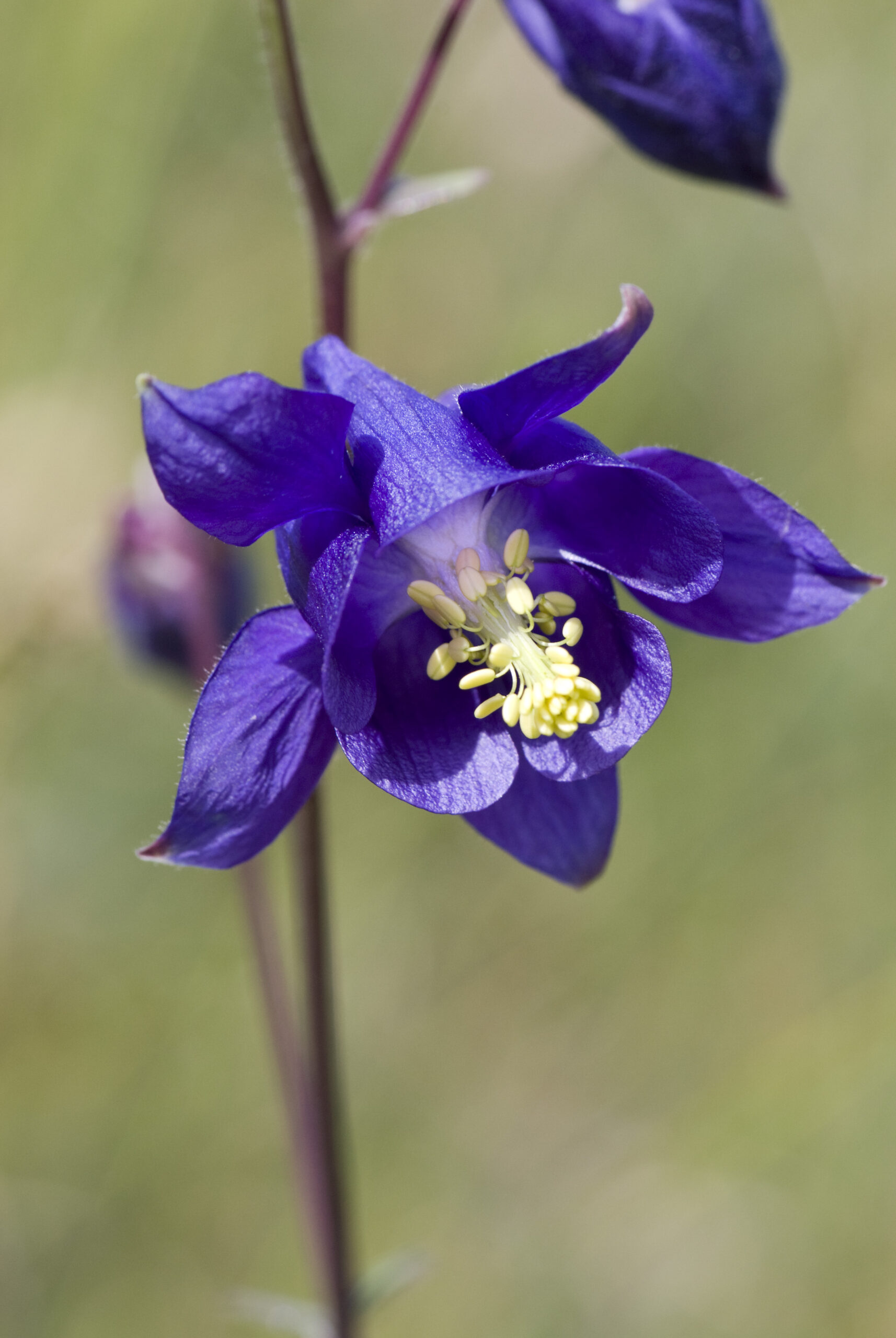
Columbines have delicate, spurred petals in often two-tone colours. They are a magnet for pollinators, especially bees and hummingbirds, where they are native.
Key facts
- Scientific name and any synonyms: Aquilegia vulgaris, Aquilegia × hybrida
- Meaning of scientific plant name: “Aquilegia” from Latin aquila (“eagle”), referring to spurs resembling eagle talons
- Common names: Columbine, granny’s bonnet
- Plant family: Ranunculaceae
- Place of origin of the plant: Northern hemisphere (Europe and North America)
- Type of plant: Herbaceous perennial
- Size: 30–90 cm tall (12–36 inches), depending on variety
- Foliage – Description of foliage: Lacy, lobed leaves forming a low clump
- Flower – Description of flower and flowering time: Nodding or upright blooms with elongated spurs; mid to late spring
- Fruit – Description of fruit (if any) and fruiting time: Pods with numerous seeds; ripen early summer
- Toxicity: Mildly toxic if ingested. Contains cardiogenic toxins causing potential stomach upset.
Care requirements
- Light requirements: Partial shade or dappled sun; tolerates full sun in cooler areas.
- Water and humidity requirements: Moderate watering; soil should remain slightly moist.
- Temperature requirements (including minimum and maximum in °F and °C) and UK/US hardiness zones: Grows in about -4 °F (-20 °C) to 80 °F (27 °C). UK hardiness: H5. US hardiness: USDA zones 3–9.
- Soil requirements: Well-draining, fertile soil; slightly acidic to neutral pH.
- Feeding requirements: Light fertiliser in spring; too much can cause leggy growth.
- Propagation – summary of main ways of propagating the plant: Self-seeds readily; also by seed or division in spring.
- Pruning – summary of when and how to prune the plant: Deadhead to prolong bloom; cut back when leaves yellow.
Best cultivars
- ’Nora Barlow’ – Double pink blooms, around 80 cm tall, heritage variety.
- ’Blue Barlow’ – Double purple-blue blooms, about 70 cm tall.
- ’McKana Giants’ – Mixed colours with long spurs, 60–90 cm tall, pollinator-friendly.
- ’Crimson Star’ – Red and white bi-colour flowers, 70 cm tall, striking.
- ’Black Barlow’ – Deep maroon, nearly black blooms, 60 cm tall, dramatic.
Brunnera (Siberian Bugloss)
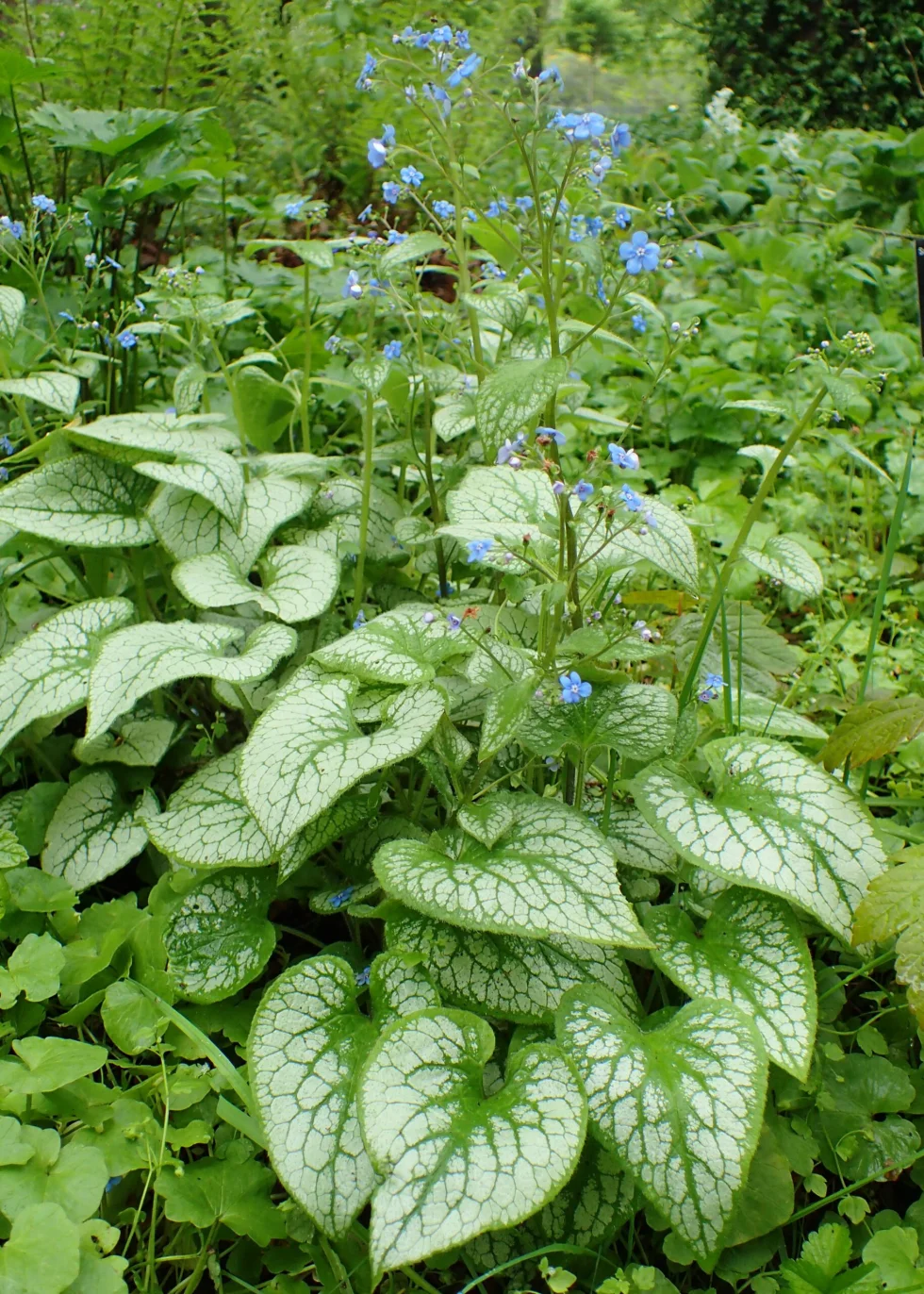
Brunnera is one of those rare plants that flowers well in shade. Its heart-shaped, often variegated leaves brighten shady areas and its sky-blue flowers resemble forget-me-nots and appear in clusters during spring.
Key facts
- Scientific name and any synonyms: Brunnera macrophylla (syn. Anchusa myosotidiflora)
- Meaning of scientific plant name: “Brunnera” honours Swiss botanist Samuel Brunner; “macrophylla” means “large-leaved”
- Common names: Siberian bugloss, false forget-me-not
- Plant family: Boraginaceae
- Place of origin of the plant: Eastern Europe and northwestern Asia
- Type of plant: Herbaceous perennial
- Size: 30–45 cm tall (12–18 inches), spreading 45–60 cm (18–24 inches)
- Foliage – Description of foliage: Large, heart-shaped leaves, often silver-variegated
- Flower – Description of flower and flowering time: Tiny, bright blue flowers in mid to late spring
- Fruit – Description of fruit (if any) and fruiting time: Small nutlets forming post-bloom, ripening late spring/early summer
- Toxicity: Not typically considered toxic; no major concerns for pets or people.
Care requirements
- Light requirements: Partial to full shade; shelter from harsh afternoon sun.
- Water and humidity requirements: Keep soil consistently moist; normal garden humidity is fine.
- Temperature requirements (including minimum and maximum in °F and °C) and UK/US hardiness zones: Hardy from about -13 °F (-25 °C) to 77 °F (25 °C). UK hardiness: H6. US hardiness: USDA zones 3–8.
- Soil requirements: Humus-rich, well-draining soil that stays evenly moist.
- Feeding requirements: Compost or balanced fertiliser in spring.
- Propagation – summary of main ways of propagating the plant: Divide in autumn or early spring; can be grown from seed.
- Pruning – summary of when and how to prune the plant: Remove spent flower stems and damaged leaves post-bloom.
Best cultivars
- ’Jack Frost’ – Silver leaves with green veins, 30 cm tall, bright blue flowers.
- ’Looking Glass’ – Nearly all-silver leaves, 35 cm tall, vivid blue blooms.
- ’Variegata’ – Green leaves with cream margins, 40 cm tall, striking contrast.
- ’Sea Heart’ – Thicker, heat-tolerant leaves, 30 cm tall, pink buds opening to blue.
- ’Silver Spear’ – Silvery foliage with dark veins, about 35 cm tall.
Basket-of-Gold (Aurinia Saxatilis)
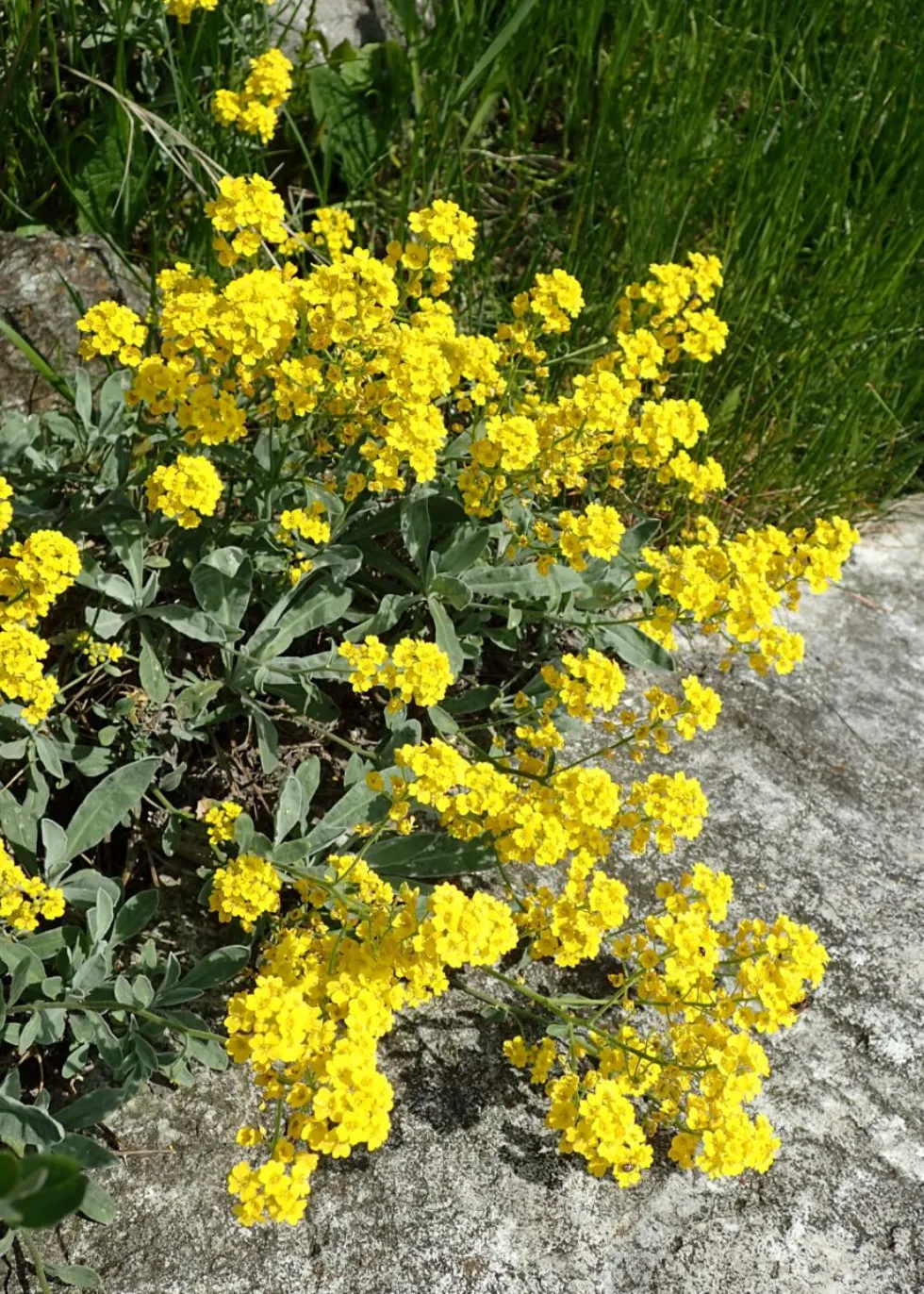
Basket-of-gold produces masses of bright yellow flowers that cascade over walls or rock gardens. Its grey-green foliage adds contrast and tolerates dryness.
Key facts
- Scientific name and any synonyms: Aurinia saxatilis (syn. Alyssum saxatile)
- Meaning of scientific plant name: “Saxatilis” means “growing among rocks,” reflecting its natural habitat
- Common names: Basket-of-gold, gold-dust, yellow alyssum
- Plant family: Brassicaceae
- Place of origin of the plant: Southern Europe and Asia Minor
- Type of plant: Evergreen perennial subshrub
- Size: 15–30 cm tall (6–12 inches), 30–60 cm spread (12–24 inches)
- Foliage – Description of foliage: Small, grey-green, slightly fuzzy leaves
- Flower – Description of flower and flowering time: Clusters of golden-yellow blooms in mid to late spring
- Fruit – Description of fruit (if any) and fruiting time: Seed pods ripening in early summer
- Toxicity: Not generally considered toxic.
Care requirements
- Light requirements: Full sun is ideal for the best flowering.
- Water and humidity requirements: Moderate to low water needs; tolerates dry conditions once established.
- Temperature requirements (including minimum and maximum in °F and °C) and UK/US hardiness zones: Hardy around -4 °F (-20 °C) up to about 86 °F (30 °C). UK hardiness: H5. US hardiness: USDA zones 3–7.
- Soil requirements: Well-draining, rocky or sandy soil; copes with poorer soils.
- Feeding requirements: Minimal feeding; too much fertiliser can reduce flowering.
- Propagation – summary of main ways of propagating the plant: Seed in spring or softwood cuttings in early summer.
- Pruning – summary of when and how to prune the plant: Shear back after flowering to maintain compact growth.
Best cultivars
- ’Compactum’ – Smaller form, 15 cm tall, dense gold blooms.
- ’Citrinum’ – Pale lemon-yellow flowers, about 20 cm tall, softer colour.
- ’Summit’ – Bright yellow blooms, 25 cm tall, vigorous.
- ’Golden Spring’ – Intense golden clusters, 20 cm tall, prolonged flowering.
- ’Goldkugel’ – Dense golden flower heads, approx. 25 cm tall.
Candytuft (Iberis Sempervirens)

Candytuft is noted for its pure white spring blooms that can blanket the plant. The evergreen foliage remains attractive, making it an excellent edging or rock garden plant.
Key facts
- Scientific name and any synonyms: Iberis sempervirens
- Meaning of scientific plant name: “Iberis” refers to the Iberian Peninsula; “sempervirens” means “always green”
- Common names: Candytuft, evergreen candytuft
- Plant family: Brassicaceae
- Place of origin of the plant: Southern Europe
- Type of plant: Evergreen subshrub/perennial
- Size: 20–30 cm tall (8–12 inches), 30–45 cm spread (12–18 inches)
- Foliage – Description of foliage: Narrow, dark green, lanceolate leaves that persist all year
- Flower – Description of flower and flowering time: Small, white clusters in mid to late spring; sometimes reblooms lightly
- Fruit – Description of fruit (if any) and fruiting time: Seed pods after flowering, maturing in early summer
- Toxicity: Generally considered non-toxic.
Care requirements
- Light requirements: Full sun for best blooms.
- Water and humidity requirements: Moderate watering; allow topsoil to dry slightly between waterings.
- Temperature requirements (including minimum and maximum in °F and °C) and UK/US hardiness zones: Hardy from about -4 °F (-20 °C) to 86 °F (30 °C). UK hardiness: H5. US hardiness: USDA zones 3–9.
- Soil requirements: Well-draining soil; slightly alkaline to neutral is fine.
- Feeding requirements: Light fertiliser in early spring. Overfeeding can reduce flowering.
- Propagation – summary of main ways of propagating the plant: Stem cuttings in summer or seed. Division is possible for larger clumps.
- Pruning – summary of when and how to prune the plant: Trim lightly after flowering for a possible second flush and to maintain shape.
Best cultivars
- ’Snowflake’ – Pure-white flowers, 20 cm tall, highly floriferous.
- ’Tahoe’ – Compact (15 cm tall), tidy growth with dense white blooms.
- ’Alexander’s White’ – Classic white blooms, 25 cm tall, glossy evergreen foliage.
- ’Findel’ – White flowers with a pinkish hue in bud, 20 cm tall.
- ’Autumn Snow’ – May rebloom in autumn, 25 cm tall.
Cranesbill Geranium (Hardy Geranium)
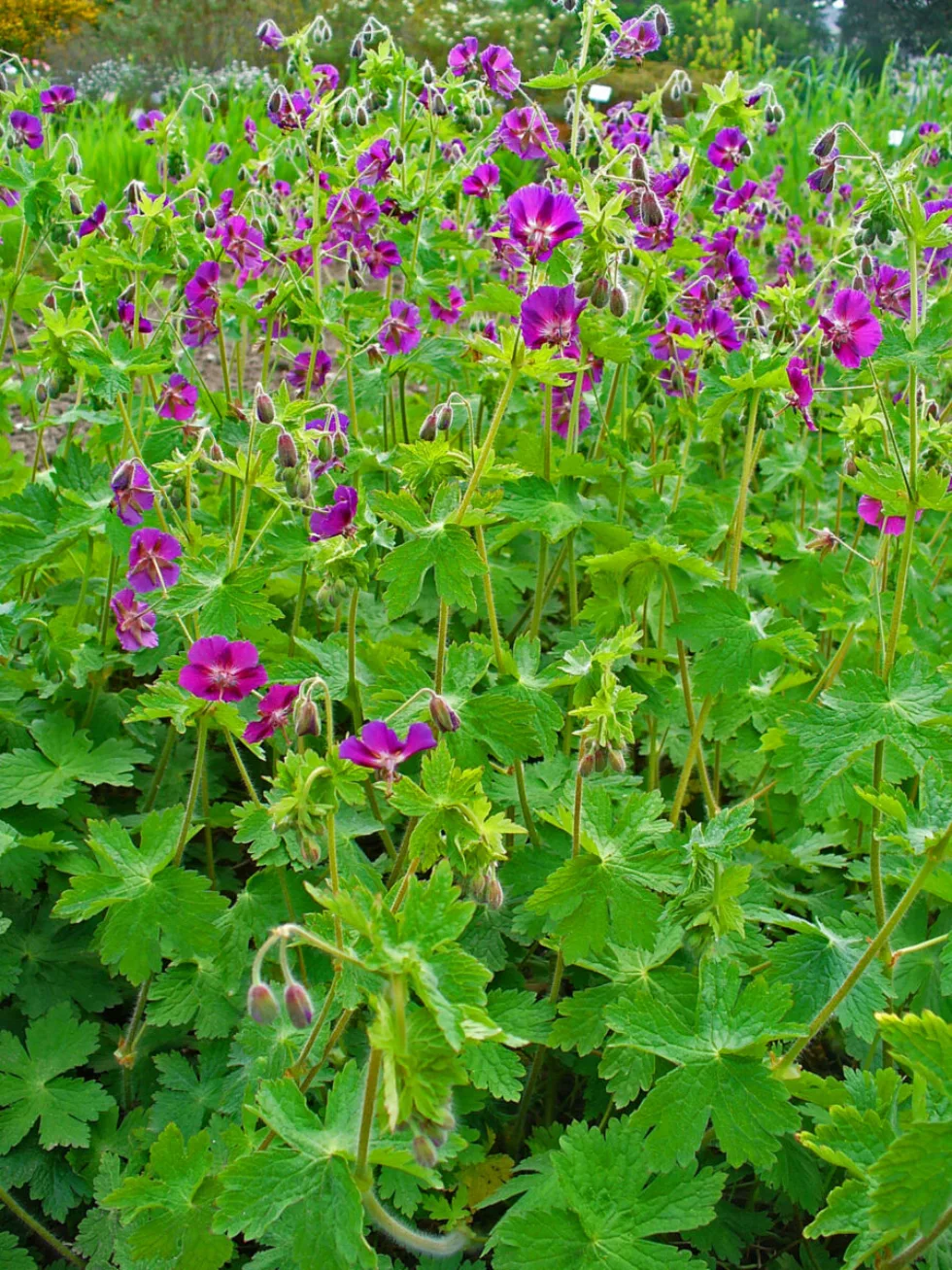
Cranesbill geraniums are known for their longevity and reliability. They offer abundant spring blooms and, in many cases, a second flush later in the season.
Key facts
- Scientific name and any synonyms: Geranium spp. (e.g., Geranium sanguineum, Geranium pratense)
- Meaning of scientific plant name: “Geranium” from Greek geranos (“crane”), referencing the beak-like seedpods
- Common names: Cranesbill, hardy geranium
- Plant family: Geraniaceae
- Place of origin of the plant: Temperate regions worldwide (Europe, Asia, North America)
- Type of plant: Herbaceous perennial
- Size: 15–90 cm tall (6–36 inches), depending on species/cultivar
- Foliage – Description of foliage: Palmate or deeply lobed leaves; some turn red or orange in autumn
- Flower – Description of flower and flowering time: Five-petalled blooms in pink, purple, blue or white; usually in spring, sometimes reblooming
- Fruit – Description of fruit (if any) and fruiting time: Slender, elongated pods resembling a crane’s bill, summer
- Toxicity: Generally considered non-toxic.
Care requirements
- Light requirements: Full sun to partial shade, depending on variety.
- Water and humidity requirements: Moderate watering; allow topsoil to dry slightly.
- Temperature requirements (including minimum and maximum in °F and °C) and UK/US hardiness zones: Many tolerate down to -4 °F (-20 °C) and up to 90 °F (32 °C). UK hardiness: H5–H7. US hardiness: USDA zones 3–9.
- Soil requirements: Well-draining, moderately fertile soil; adaptable to different pH.
- Feeding requirements: Light balanced fertiliser in spring.
- Propagation – summary of main ways of propagating the plant: Divide clumps in spring or autumn; some can be grown from seed.
- Pruning – summary of when and how to prune the plant: Deadhead to prolong flowering; shear back after blooming to encourage fresh growth.
Best cultivars
- ’Rozanne’ – Violet-blue flowers, about 40 cm tall, extremely long flowering season.
- ’Johnson’s Blue’ – Bright lavender-blue blooms, 45 cm tall, cottage garden favourite.
- ’Wargrave Pink’ – Salmon-pink flowers, 30 cm tall, repeat blooms with deadheading.
- ’Patricia’ – Magenta-pink blooms with a black eye, 60 cm tall, vigorous habit.
- ’Biokovo’ – White petals tinged with pink, 20 cm tall, excellent ground cover.
Globe Flower (Trollius)
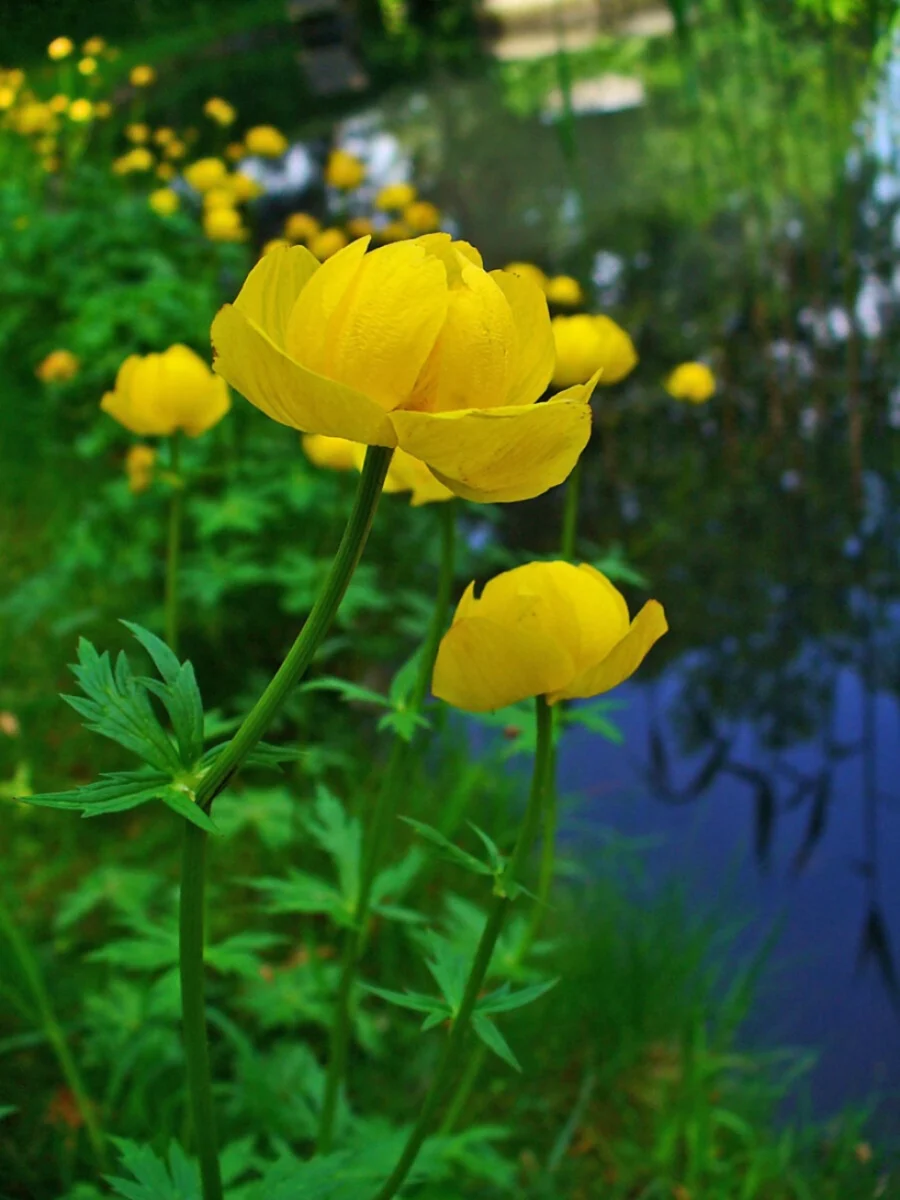
Globe flowers produce bright, rounded blooms, often in yellow or orange. They thrive in moist soil, making them ideal by ponds or in boggy areas.
Key facts
- Scientific name and any synonyms: Trollius europaeus, Trollius chinensis, and hybrids
- Meaning of scientific plant name: “Trollius” may come from the German Troll (“round lump”), describing the globe-like blooms
- Common names: Globe flower, globe buttercup
- Plant family: Ranunculaceae
- Place of origin of the plant: Europe, Asia, and North America (varies by species)
- Type of plant: Herbaceous perennial
- Size: 30–90 cm tall (12–36 inches), depending on species
- Foliage – Description of foliage: Deeply lobed leaves forming tidy clumps
- Flower – Description of flower and flowering time: Spherical, layered petals in yellow or orange; spring to early summer
- Fruit – Description of fruit (if any) and fruiting time: Small, dry follicles containing seeds, maturing early to mid-summer
- Toxicity: Mildly toxic if eaten; sap can irritate skin. Contains ranunculin.
Care requirements
- Light requirements: Full sun to partial shade; prefers some shade in hotter regions.
- Water and humidity requirements: Needs consistently moist soil; appreciates higher humidity.
- Temperature requirements (including minimum and maximum in °F and °C) and UK/US hardiness zones: Tolerates about -4 °F (-20 °C) up to 77 °F (25 °C). UK hardiness: H5. US hardiness: USDA zones 3–7.
- Soil requirements: Rich, moist, slightly acidic to neutral.
- Feeding requirements: Compost or balanced fertiliser in spring.
- Propagation – summary of main ways of propagating the plant: Divide in early spring or after flowering; can be grown from seed.
- Pruning – summary of when and how to prune the plant: Deadhead spent blooms to prolong flowering; remove old foliage in autumn.
Best cultivars
- ’Golden Queen’ – Orange-yellow blooms, about 60 cm tall, classic variety.
- ’Cheddar’ – Pale creamy-yellow flowers, 45 cm tall, soft colour.
- ’New Moon’ – Lemon-yellow, 50 cm tall, semi-double blooms.
- ’Alabaster’ – Light yellow, nearly white, 40 cm tall, elegant blooms.
- ’Orange Princess’ – Bright orange petals, 60 cm tall, showy and bold.
Epimedium (Barrenwort)
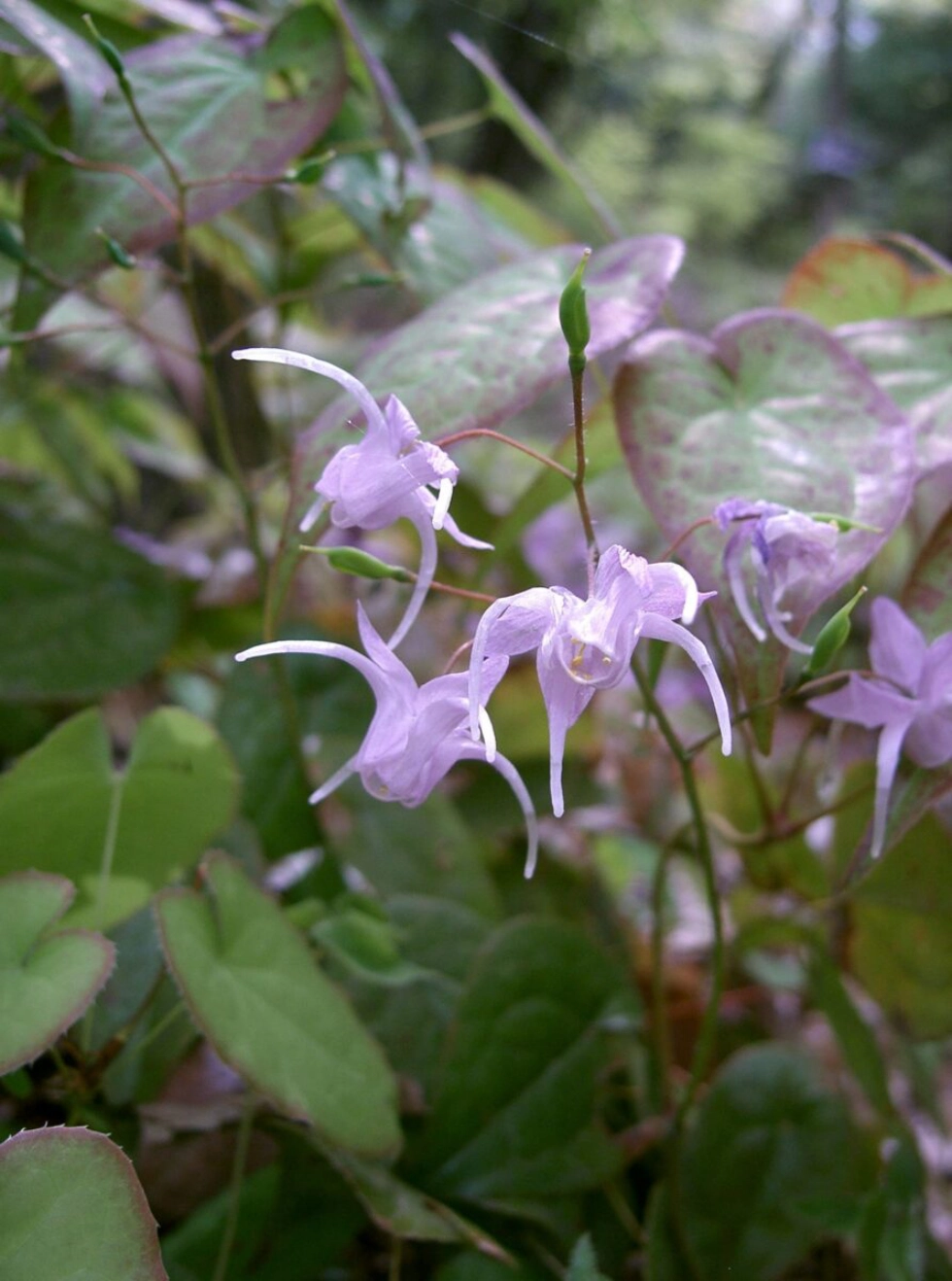
Epimedium has dainty, fairy-like flowers and attractive foliage that often emerges with a red or bronze tint. Many species retain their leaves through winter.
Key facts
- Scientific name and any synonyms: Epimedium spp. (e.g., Epimedium x versicolor, Epimedium grandiflorum)
- Meaning of scientific plant name: “Epimedium” likely references a Greek or Mediterranean origin (exact etymology uncertain)
- Common names: Barrenwort, bishop’s hat, fairy wings
- Plant family: Berberidaceae
- Place of origin of the plant: Asia (China, Japan) and parts of the Mediterranean
- Type of plant: Herbaceous or semi-evergreen perennial
- Size: 20–40 cm tall (8–16 inches), forming spreading clumps
- Foliage – Description of foliage: Heart-shaped, often red-tinted new leaves; can be evergreen or semi-evergreen
- Flower – Description of flower and flowering time: Tiny, nodding or spurred blooms in white, yellow, pink or orange; mid-spring
- Fruit – Description of fruit (if any) and fruiting time: Seed pods form after flowering; not typically ornamental
- Toxicity: Generally non-toxic. Some species used medicinally, but not advised for culinary use without expert guidance.
Care requirements
- Light requirements: Partial to full shade; morning sun is acceptable.
- Water and humidity requirements: Keep soil consistently moist, especially during establishment; moderate humidity is fine.
- Temperature requirements (including minimum and maximum in °F and °C) and UK/US hardiness zones: Tolerates around -4 °F (-20 °C) to 86 °F (30 °C). UK hardiness: H5. US hardiness: USDA zones 5–9 (varies by species).
- Soil requirements: Well-draining, humus-rich soil with organic matter.
- Feeding requirements: Light mulch or compost in spring; minimal fertiliser needed.
- Propagation – summary of main ways of propagating the plant: Divide in spring or autumn; some species from seed.
- Pruning – summary of when and how to prune the plant: Trim old foliage in late winter to reveal flowers and fresh growth.
Best cultivars
- ’Rubrum’ – Red-pink outer petals, pale centres, 25 cm tall, bronze new leaves.
- ’Orange Queen’ – Soft orange blooms, 30 cm tall, semi-evergreen leaves.
- ’Frohnleiten’ – Bright yellow blooms, about 30 cm tall, red-flushed new foliage.
- ’Purple Prince’ – Purple blooms, 20 cm tall, good ground cover.
- ’Domino’ – Creamy white flowers with pink tinge, 35 cm tall, marbled foliage.
Leopard’s Bane (Doronicum Orientale)

Leopard’s bane is among the first daisies of spring, offering cheerful yellow blooms that can grow in partial shade. They’re a welcome splash of colour in woodland edges.
Key facts
- Scientific name and any synonyms: Doronicum orientale (syn. Doronicum caucasicum)
- Meaning of scientific plant name: “Doronicum” is from an Arabic name for similar plants; “orientale” indicates eastern origin
- Common names: Leopard’s bane, little leopard’s bane
- Plant family: Asteraceae
- Place of origin of the plant: Southeastern Europe to western Asia
- Type of plant: Herbaceous perennial
- Size: 30–45 cm tall (12–18 inches), clumping habit
- Foliage – Description of foliage: Heart-shaped or oval bright green leaves, sometimes softly hairy
- Flower – Description of flower and flowering time: Yellow daisy-like blooms in mid to late spring
- Fruit – Description of fruit (if any) and fruiting time: Small seed heads, ripening in early summer
- Toxicity: Can be harmful if ingested in large amounts. The RHS notes potential discomfort; keep away from pets and children.
Care requirements
- Light requirements: Partial shade or full sun in cooler areas.
- Water and humidity requirements: Moderate watering; prefers consistent moisture but not soggy soil.
- Temperature requirements (including minimum and maximum in °F and °C) and UK/US hardiness zones: Survives about -4 °F (-20 °C) up to 77 °F (25 °C). UK hardiness: H5. US hardiness: USDA zones 4–7.
- Soil requirements: Fertile, well-draining soil; slightly acidic to neutral pH.
- Feeding requirements: Light fertiliser in early spring.
- Propagation – summary of main ways of propagating the plant: Divide in spring or autumn; can be grown from seed.
- Pruning – summary of when and how to prune the plant: Deadhead spent blooms to prolong flowering; cut back foliage as it fades.
Best cultivars
- ’Little Leo’ – Compact form (20 cm tall), bright golden blooms, good for containers.
- ’Leonardo Compact’ – Around 25 cm tall, large yellow daisies, neat habit.
- ’Harlequin’ – Variegated foliage, 30 cm tall, bright yellow blooms, distinctive leaves.
- ’Magnificum’ – Taller (up to 60 cm), large showy blooms.
- ’Spring Beauty’ – 35 cm tall, abundant yellow flowers, tidy form.
Iris (Bearded or Siberian)
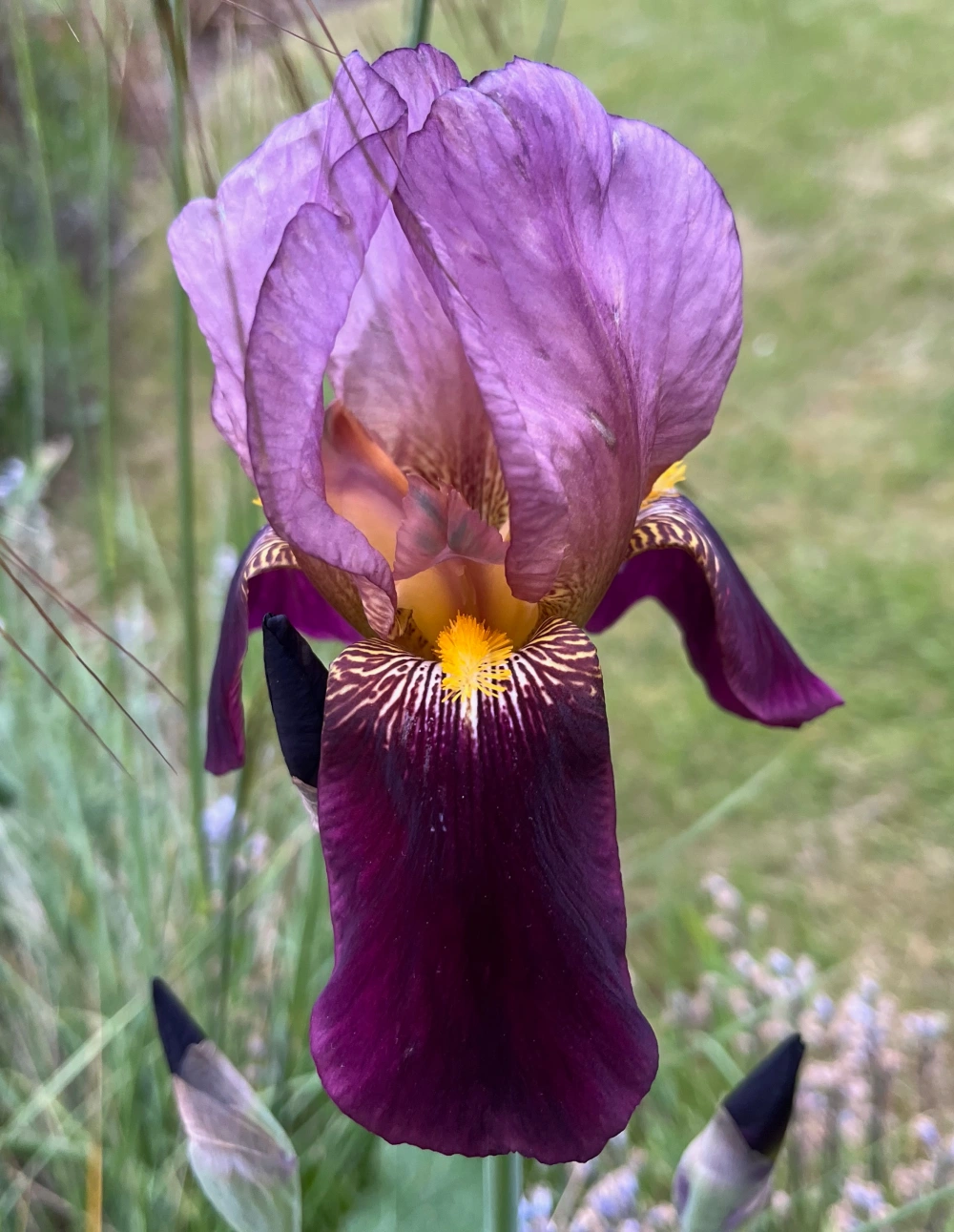
Irises are famed for their stately, intricate blooms, with “falls” (lower petals) and “standards” (upper petals). Bearded irises prefer drier conditions; Siberian irises thrive in more moisture.
Key facts
- Scientific name and any synonyms: Iris germanica (bearded iris), Iris sibirica (Siberian iris), plus numerous hybrids
- Meaning of scientific plant name: “Iris” is Greek for “rainbow,” reflecting the wide colour range
- Common names: Bearded iris, Siberian iris, flags
- Plant family: Iridaceae
- Place of origin of the plant: Europe, Asia, North America (varies by species)
- Type of plant: Rhizomatous or clump-forming perennial
- Size: Bearded iris: 30–90 cm (12–36 inches). Siberian iris: 60–100 cm (24–40 inches).
- Foliage – Description of foliage: Sword-like leaves; often grey-green for bearded types, bright green for Siberian
- Flower – Description of flower and flowering time: Showy blooms in spring to early summer, available in nearly every colour
- Fruit – Description of fruit (if any) and fruiting time: Elongated pods with seeds, ripening early summer
- Toxicity: Rhizomes and leaves can be toxic if ingested; sap may irritate skin. The ASPCA warns of vomiting, drooling, and diarrhoea in pets.
Care requirements
- Light requirements: Full sun for most irises; Siberian types can handle partial shade.
- Water and humidity requirements: Bearded iris prefer moderate watering with excellent drainage; Siberian iris enjoy more moisture.
- Temperature requirements (including minimum and maximum in °F and °C) and UK/US hardiness zones: Generally hardy to -4 °F (-20 °C); upper range about 86 °F (30 °C). UK hardiness: H7. US hardiness: USDA zones 3–9.
- Soil requirements: Bearded iris: well-draining soil. Siberian iris: tolerates heavier soils.
- Feeding requirements: Low-nitrogen fertiliser in spring and after flowering.
- Propagation – summary of main ways of propagating the plant: Rhizome division (bearded) or clump division (Siberian) post-flowering.
- Pruning – summary of when and how to prune the plant: Remove spent flower stalks; trim leaves in autumn to reduce pests/diseases.
Best cultivars
- ’Jane Phillips’ (Bearded) – Powder-blue flowers, about 80 cm tall, fragrant.
- ’Siberian Caesar’s Brother’ (Siberian) – Rich purple blooms, 90 cm tall, vigorous.
- ’Bumblebee Deelite’ (Bearded) – Yellow standards with maroon falls, 40 cm tall.
- ’Silver Edge’ (Siberian) – White flowers edged in silver, 70 cm tall.
- ’Immortality’ (Bearded) – Pure white blooms, about 80 cm tall, can rebloom.
Peony (Paeonia)
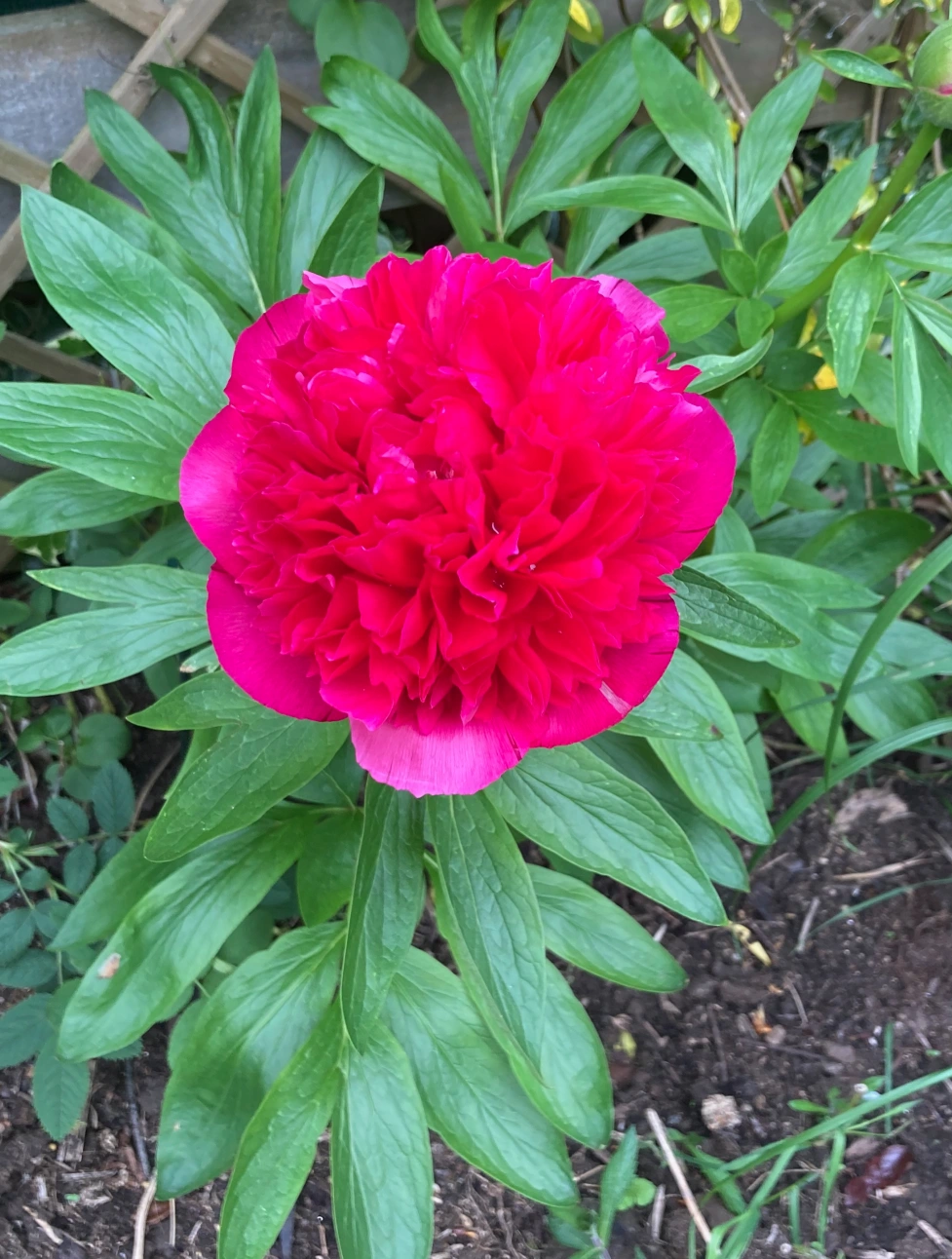
Peonies boast large, often fragrant blooms that emerge in late spring. Once established, they can flourish for decades in the same spot, producing a spectacular show each year.
Key facts
- Scientific name and any synonyms: Paeonia lactiflora (Chinese peony), Paeonia officinalis (common peony), plus hybrids
- Meaning of scientific plant name: “Paeonia” honours Paeon, physician to the Greek gods, reflecting historical medicinal uses
- Common names: Peony, garden peony
- Plant family: Paeoniaceae
- Place of origin of the plant: Asia, southern Europe, western North America
- Type of plant: Herbaceous perennial (tree peonies are woody)
- Size: 60–90 cm tall (24–36 inches), similar spread
- Foliage – Description of foliage: Glossy, divided leaves often taking on red or gold hues in autumn
- Flower – Description of flower and flowering time: Large, bowl-shaped, sometimes double blooms in white, pink, red, yellow; mid to late spring
- Fruit – Description of fruit (if any) and fruiting time: Follicles containing seeds, developing in early summer
- Toxicity: Mildly toxic to pets if ingested, causing vomiting or diarrhoea (ASPCA notes paeonol in bark as irritant).
Care requirements
- Light requirements: Full sun (at least six hours a day) for best flowering.
- Water and humidity requirements: Moderate; avoid waterlogging. Normal humidity is sufficient.
- Temperature requirements (including minimum and maximum in °F and °C) and UK/US hardiness zones: Hardy to about -13 °F (-25 °C), up to around 86 °F (30 °C). UK hardiness: H7. US hardiness: USDA zones 3–8.
- Soil requirements: Fertile, well-draining soil, neutral to slightly alkaline pH.
- Feeding requirements: Balanced fertiliser in spring when shoots appear, and again after flowering.
- Propagation – summary of main ways of propagating the plant: Division of tuberous roots in autumn; seed is slow and less common.
- Pruning – summary of when and how to prune the plant: Cut back foliage to ground level in autumn; remove spent blooms promptly.
Best cultivars
- ’Sarah Bernhardt’ – Large, fully double pink blooms, about 90 cm tall, fragrant.
- ’Karl Rosenfield’ – Vibrant red double flowers, 80 cm tall, a classic.
- ’Bowl of Beauty’ – Semi-double pink with cream centre, 90 cm tall, striking form.
- ’Festiva Maxima’ – White double blooms flecked with crimson, 90 cm tall, perfumed.
- ’Duchesse de Nemours’ – Pure white double blooms, 90 cm tall, elegantly fragrant.
These 15 spring flowering perennials add a burst of colour and life to the garden after winter’s dormancy. Each brings its own charm—whether that’s early blooms pushing through snow, unusual leaf patterns, or pollinator-friendly flowers.
By choosing varieties that suit your conditions, you’ll enjoy beautiful displays year after year.
Martin Cole has been an avid plant lover and gardener for more than 20 years and loves to talk and write about gardening. In 2006 he was a finalist in the BBC Gardener of the Year competition. He is a member of the National dahlia Society.
He previously lived in London and Sydney, Australia, where he took a diploma course in Horticultural studies and is now based in North Berwick in Scotland. He founded GardeningStepbyStep.com in 2012. The website is aimed at everybody who loves plants or has been bitten by the gardening bug and wants to know more.
Gardening Step by Step has been cited by Thompson and Morgan, the UK’s largest mail order plant retailer, as a website that publishes expert gardening content.


